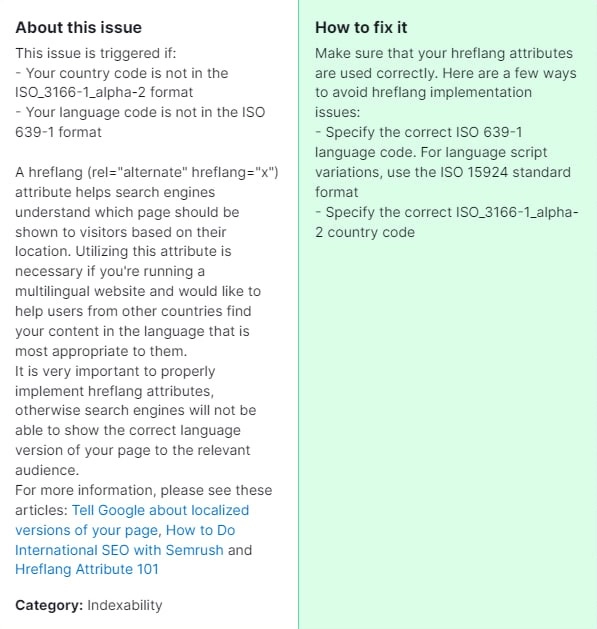Hreflang tags are HTML attributes used to specify the language and geographical targeting of a webpage. These tags are crucial for websites with multilingual or multinational content as they help search engines understand which version of a page to display to users based on their language and location preferences.

Why is it important for you to fix this error?
Fixing Hreflang value issues is important for several reasons:
- Improved User Experience: Correct hreflang tags ensure that users are directed to the most relevant version of a webpage based on their language and location, enhancing their browsing experience.
- Enhanced SEO Performance: Proper implementation of hreflang tags helps search engines index and rank the right version of a webpage for the appropriate audience, potentially boosting organic search visibility and traffic.
- Avoiding Penalties: Search engines may penalize websites with incorrect or inconsistent hreflang tags, leading to a decrease in search rankings and organic traffic.
How to Fix “Issues with hreflang values” Detected by a Semrush Audit?

1. Identify Hreflang Issues
Begin by conducting a comprehensive audit of your website using Semrush or similar SEO auditing tools to identify any hreflang value issues. These issues may include missing hreflang tags, incorrect language or country codes, or inconsistent hreflang values across different versions of a webpage.
2. Review Hreflang Implementation
Analyze the existing hreflang tags on your website to determine where the issues lie. Pay attention to the language and country codes specified in the hreflang attributes and ensure they accurately reflect the targeted audience for each version of the webpage.
3. Correct Syntax Errors:
Check for any syntax errors in the hreflang tags, such as missing quotation marks or incorrect attribute formatting. Make necessary corrections to ensure that the hreflang tags comply with HTML standards.
4. Ensure Consistency
Ensure consistency in hreflang values across all versions of a webpage. Language and country codes should be standardized and accurately reflect the intended targeting.
5. Validate Hreflang Tags
Utilize tools like Google’s Search Console or third-party validation tools to validate the correctness of your hreflang tags. Address any errors or warnings reported during the validation process.
6. Implement Canonical Tags
In cases where multiple versions of a webpage exist for different languages or regions, implement canonical tags to specify the preferred version of the page. This helps prevent duplicate content issues and ensures proper indexing by search engines.
7. Test and Monitor
After implementing the necessary fixes, thoroughly test the hreflang tags to ensure they are functioning correctly. Monitor search engine performance and user behavior to gauge the effectiveness of the changes over time.
8. Regular Maintenance
Hreflang value issues can arise due to website updates, changes in content, or other factors. Regularly monitor and maintain hreflang tags to prevent issues from recurring and to adapt to any changes in your website or target audience.
By following these steps, you can effectively address and fix “Issues with hreflang values” detected by a Semrush audit, ensuring optimal language targeting and SEO performance for your website. But if you have any difficulties with this issue, we recommend that you contact our specialists.




